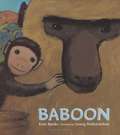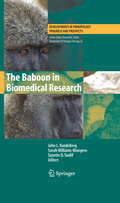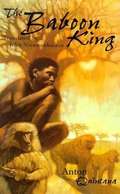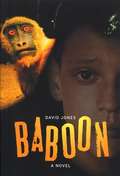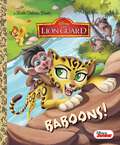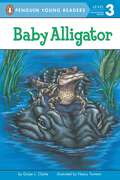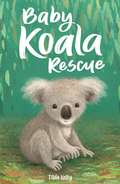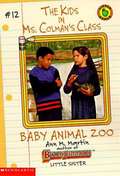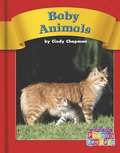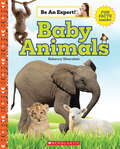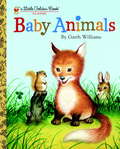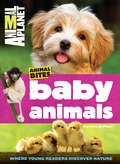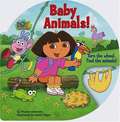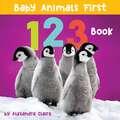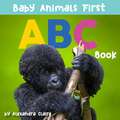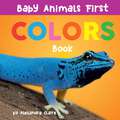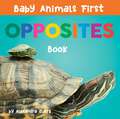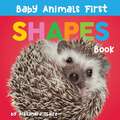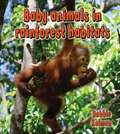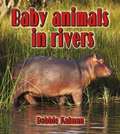- Table View
- List View
Baboon
by Kate BanksOn his first trip into the world, a baby baboon meets a very slow turtle and concludes that the world is slow. But then, as his mother takes him farther afield, he sees much more: he watches a hungry crocodile, a thundering herd of elephants, a swift gazelle, a rhinoceros. He feels the heat of a fire, the softness of grass, the warmth of the sun. Throughout the day, everything he experiences expands his understanding, and when night falls, he has seen with his own eyes that the world is a big and varied place. <P><P>With its simple, rhythmic text and bold, impressionistic jungle pictures, Baboon is a book to share with children as they explore their own new worlds.
The Baboon in Biomedical Research
by Suzette D. Tardif John L. Vandeberg Sarah Williams-BlangeroThe present volume was written to provide an overview of many diverse areas of biomedical research to which the baboon has made and continues to make important contributions. Each chapter reviews the recent literature on the topic, discusses work in progress, and presents the authors' vision of research opportunities and likely future contributions of the baboon model to human medicine. The baboon is a relative newcomer to the repertoire of nonhuman primates used in biomedical research. However, in less than 50 years since its first use in the U.S. it has become one of the most popular laboratory primate species. It is larger than the other widely used monkey species, making it advantageous for many types of experiments and technological developments. It is extraordinarily hardy and highly fecund in captivity. It closely resembles humans in a variety of physiological and disease processes, such as cholesterol metabolism, early stages of atherosclerosis, and alcoholic liver disease. Its chromosomes closely resemble those of humans, and many genes of the two species lie in the same chromosomal order. Among all primates, baboons are the most widely used as models for the genetics of susceptibility to complex diseases and they are the first nonhuman primate for which a framework genetic linkage map was established. In addition, the baboon genome is currently being sequenced, and as a result the utility of this species for biomedical research will be dramatically increased. For all of these reasons, the baboon is certain to continue as one of the premier nonhuman species used in medical research.
The Baboon King
by Anton Quintana John NieuwenhuizenMorengaru, a strong young hunter, has been cast out by both his mother's people, the Kikuyu, and his father's people, the Masai. Every day he misses human companionship, and soon he feels as though he's becoming more like the animals around him. When Morengaru has the chance to belong again, he seizes the opportunity. Then he faces the greatest challenge of his life: living among the baboons, still clinging to his humanity, hoping someday to return to his people.
Baboon, A Novel
by David JonesA plane crash. A mysterious transformation. An adventure unlike any other. Fourteen-year-old Gerry Copeland has mixed feelings about flying back to his parents' research camp in the African savanna. While his biologist mom and dad study baboon behavior, he'll be thinking about the video arcade and restaurants back in the city. Suddenly, their small plane's engine stutters and dies. They go down hard. Gerry wakes up thinking a baboon has broken his fall. He's shocked to realize the furry arm is his own. Somehow, he's become one of the beasts his parents are studying. Adopted by baboons, Gerry's only chance to survive is to stay with the baboon troop. His parents don't recognize him, and he begins to lose hope he'll ever be human again. His final, desperate bid to turn back means giving up the animal family he's come to care about for the human family where he truly belongs. Baboon is the riveting story of one teenager's journey into the heart of the baboon world, where he confronts terrifying attacks by predators and humans, threatening behavior within the troop, and the day-to-day struggle to survive.
Baboon Perspectives on Early Human Ancestors: One Approach to Reconstructing Early Hominin Ecology and Behavior
by Glenn E. KingBaboon Perspectives on Early Human Ancestors brings together the most recent information on the behavior and ecology of Papio baboons and early hominins. Building on a long tradition and integrating recent developments, it discusses the ways that baboon behavior can enhance our understanding of our early ancestors. This approach augments interpretation of the archeological record and provides hypotheses for the gaps in the record and for the millions of years before the record began. Baboon behavior complements the widely used chimpanzee models, but also generates competing hypotheses. Among the many topics covered in the book are foraging and predator defense; multi-level societies and male-female relationships; social and ecological cognition; and communication and the roots of language.
Baboons! (Little Golden Book)
by Apple JordanChildren ages 2 to 5 will enjoy reading this adventurous story about Kion and the rest of the amazing Lion Guard as they rescue a baby baboon from some hungry vultures! This full-color Little Golden Book retells an episode of the hit Disney Junior series.
Baboons and Other Old World Monkeys
by Steven A. HorakFrom the book: * When a baboon yawns, it is often making a threat. * Silvered leaf monkeys are born bright orange. * A male gelada baboon threatens other males by flipping his upper lip up and down. * De Brazza's monkeys almost never eat just half a fruit. * Many Old World monkeys bob their heads when they feel threatened. * Colobus monkeys have no thumbs. * When in danger, a proboscis monkey troop will often dive into a river.
Baboons (Nature's Children)
by Tom JacksonDescribes the physical features, habits and natural environment of Baboons.
Baby Alligator (Penguin Young Readers, Level 3)
by Ginjer L. ClarkeDeep in the swamp, a baby alligator crawls out of its broken shell. What's in store for this little reptile? Follow it through its first adventures, and get a glimpse into the world of these amazing creatures. The easy-to-read text describes how alligators live, from what they eat to how they swim so quickly. You'll also find fun facts about alligators' dinosaur-hunting ancestors and their more contemporary cousin, the crocodile.
Baby Animal Friends: Book 2 (Baby Animal Friends #2)
by Tilda KellyA tragic bush fire sparks a beautiful friendship between a young girl and a baby koala. Ruby is dreading changing schools as her autism makes it hard to befriend other kids. But when her dog finds a baby koala and her family agrees to foster it, Ruby quickly becomes the koala's best friend. Ruby loves quiet and routine, which makes her a perfect koala carer! A talented artist, she names the koala Pablo - after her favourite artist. Through looking after Pablo, Ruby befriends a neighbouring girl who loves painting as much as she does. Soon Pablo is well enough to move to a koala kindergarten. But is Ruby ready to move to her own new school?
Baby Animal Zoo (The Kids in Ms. Colman's Class #12)
by Ann M. MartinPamela is afraid of animals, but with the help of a zookeeper and a cute baby turtle, she overcomes her fear.
Baby Animals
by Cindy ChapmanPhonics Readers is a recognized leader in helping you teach phonics and phonemic awareness, within the context of content-area reading. Content area focus: Animal Families Phonics Skills: short i, c, d, w, y
Baby Animals (Fountas & Pinnell Classroom, Guided Reading Kindergarten)
by Peter GeorgeNIMAC-sourced textbook
Baby Animals (Be an Expert!)
by Rebecca SilversteinKids love to be the experts! Now they can feel like real pros with this exciting nonfiction series for beginning readers. Kids will be hooked on the thrilling real-world topics and big, bright photos. Each book features simple sentences and sight words that children can practice reading. Then, with support, kids can dig deeper into the extra facts, Q&As, and fun challenges.Fans of this series will be eager to become real experts!Some are tiny. Some are huge. They are all adorable! What do you know about baby animals like the lion cub, the kangaroo joey, and the rabbit kit? With this book you can become an expert!
Baby Animals (Little Golden Book)
by Garth WilliamsNO ONE HAS illustrated animals with as much warmth, humor, and realism as Garth Williams. This classic, full of soft and furry animal babies, features his work at his best. This longtime favorite has been reissued for a new generation of kids who will love to "pet" the animals on each page!From the Hardcover edition.
Baby Animals (Animal Planet Animal Bites)
by Dorothea De PriscoThis fun addition to the Animal Bites series provides kids in the first years of schooling with the perfect bite-sized view of their favorite animals. Arranged thematically with a focus on animal behavior and family relationships, young readers will explore sections about life cycles, feeding, play time, conservation, getting around, and much more. Special book features designed for this age group include simple infographics and 'All Grown Up' animal facts to help kids learn more about how young and adult animals differ-just like humans!
Baby Animals! (Dora the Explorer)
by Phoebe BeinsteinMama Llama's baby is hiding. So is Papa Porcupine's. Can Dora find them? Youngsters can turn the wheel on the side of this board book and match these adorable creatures with their families.
Baby Animals First 123 Book (Baby Animals First Series #1)
by Alexandra ClaireOne lonely baby raccoon is joined by two fluffy owlets, three pink little piglets, and onward to ten curious meerkats, building an adorable menagerie of baby animals. Filled with eye-catching photos of animals in their natural surroundings and paired with playful rhymes, Baby Animals First 123 Book will instill a love of nature while teaching children to count.Sized perfectly for curious little hands to hold, children will delight in learning from a wide array of creatures in the Baby Animals First series. The series expands with age, as young children will be attracted to the tactile cover and vibrant photographs, while older kids will engage with the rhyming text that teaches early learning concepts.
Baby Animals First ABC Book (Baby Animals First Series #2)
by Alexandra ClaireFrom a scaly little alligator hatchling to a long-legged zebra foal, Baby Animals First ABC Book introduces twenty six adorable baby animals to young readers. Filled with eye-catching photos of animals in their natural surroundings paired with playful rhymes, this book will instill a love of nature while teaching the ABCs. Sized perfectly for curious little hands to hold, children will delight in learning from a wide array of creatures in the Baby Animals First series. The series expands with age, as young children will be attracted to the tactile cover and vibrant photographs, while older kids will engage with the rhyming text that teaches early learning concepts.
Baby Animals First Colors Book (Baby Animals First Series #3)
by Alexandra ClaireA little red crab, fluffy yellow ducklings, a vibrant purple seahorse, and soft pink piglets join together to welcome toddlers to the wide world of color. Filled with eye-catching photos of animals in their natural surroundings and paired with playful rhymes, Baby Animals First Colors Book will instill a love of nature while introducing children to all of the colors in a rainbow of adorable baby animals.Sized perfectly for curious little hands to hold, children will delight in learning from a wide array of creatures in the Baby Animals First series. The series expands with age, as young children will be attracted to the tactile cover and vibrant photographs, while older kids will engage with the rhyming text that teaches early learning concepts.
Baby Animals First Opposites Book (Baby Animals First Series)
by Alexandra ClaireA small field mouse is dwarfed by a big whale calf, a tall baby giraffe towers over a short baby hedgehog, and a fast colt races along while a slow little sloth has a leisurely climb. Filled with colorful, eye-catching photos of baby animals in their natural surroundings and paired with playful rhythms, Baby Animals First Opposites Book will instill a love of nature while teaching children all about opposites. Sized perfectly for curious little hands to hold, children will delight in learning from a wide array of creatures in the Baby Animals First series. The series expands with age, as young children will be attracted to the tactile cover and vibrant photographs, while older kids will engage with the rhyming text that teaches early learning concepts. PRAISE FOR THE SERIES: &“Charming and educational in one joyful package&” —School Library Journal
Baby Animals First Shapes Book (Baby Animals First Series)
by Alexandra ClaireA cute hedgehog curls into a circular ball, a diamond-shaped stingray glides across the ocean floor, and a young praying mantis watches the world through the wide eyes in its triangular head. Filled with colorful, eye-catching photos of baby animals in their natural surroundings and paired with playful rhymes, Baby Animals First Shapes will instill a love of nature while teaching children all about shapes. Sized perfectly for curious little hands to hold, children will delight in learning from a wide array of creatures in the Baby Animals First series. The series expands with age, as young children will be attracted to the tactile cover and vibrant photographs, while older kids will engage with the rhyming text that teaches early learning concepts.
Baby Animals In Rainforest Habitats (Habitats of Baby Animals)
by Bobbie KalmanChildren will love the photos of the exotic baby animals that live in rain forests around the world, such as tigers, monkeys, lemurs, elephants, and sloths. Young readers will also learn about the different kinds of rain forests and discover what life is like for baby animals in both wet and dry seasons.
Baby Animals in Rivers (Habitats of Baby Animals)
by Bobbie KalmanChildren will learn about river habitats and the animals that live in them and along their banks. Baby beavers, crocodiles, brown bears, otters, swans, geese, tigers, and hippos are some of the animals featured. Young readers will learn about a river food chain, learn which animals are herbivores, carnivores, or omnivores, and discover how baby reptiles, birds, and mammals find food in their river homes.
